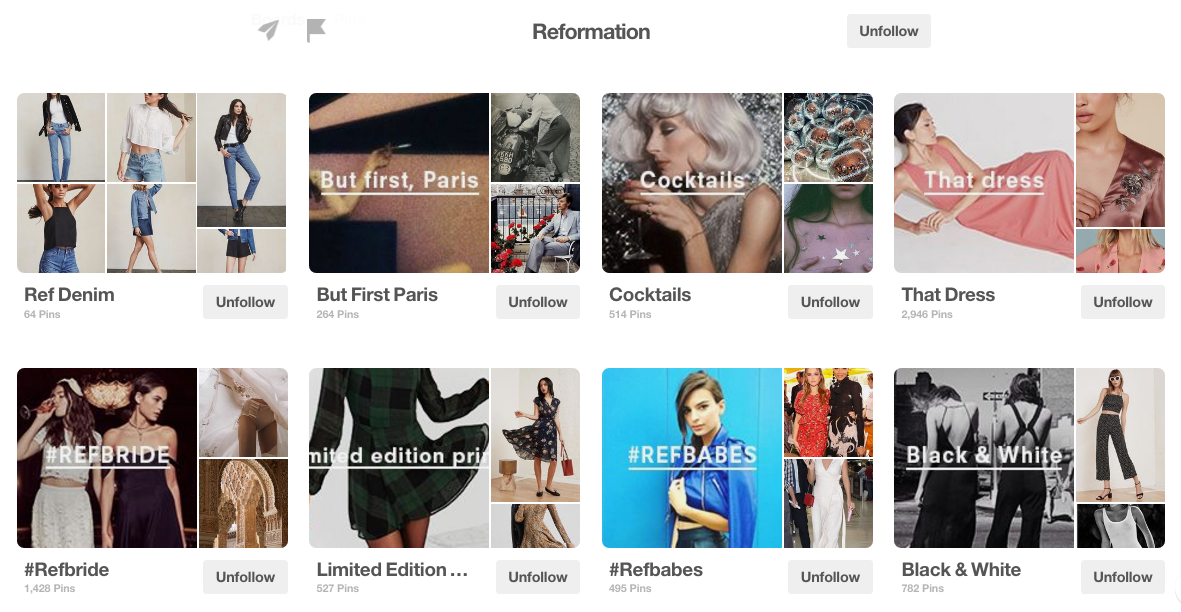Pinterest can be a time consuming platform unless you are dedicated to building it out and engaging on it. So, if you are already swamped with Instagram then please don’t try to launch a Pinterest platform until you’ve got it down. If you have been working on Pinterest but want to optimize your results and make it work this blog post is for you.
- Segment and Create lifestyle boards with product, not just product pages.
- I cannot tell you how often I see Pinterest boards that only have product. As if it were some kind of catalogue. This is not the purpose of Pinterest and doesn’t work with the audience you are looking to convert. Make sure your boards have inspirational, lifestyle images, and products all mixed together.
- For segmentation please create different themes as if you were merchandising an editorial story. Boards that are titled “dresses” or “pants” have nowhere to grow. You will just end up with an ever-expanding dress category. Think about topics like Summer 17 Dresses or Fall Coats Trends or even Dress Staples (for categories that are season less). The goal here is to get someone to engage with your point of view.
- Add the “Buyable Pins” function to your products
- This is an obvious one, but still not used as much as it should be. Enable your business account and start creating buyable pins. These pins should not just be straight product shots; they should be lifestyle shots that showcase the product. Once you have buyable pins, and people hearting and saving them, then you can enact a more strategic approach to price changes. When you make price adjustments or do flash sales a notification will go off to those who have engaged with it- so use it wisely.

- Make sure you are using strategic long-tail keywords for your pins.
- Long-tail keywords is probably something you have heard before regarding Google AdWords. It’s also important for Pinterest. Long-tail keywords tend to attract real buyers who are ready to convert. A good example of this is the difference between someone typing in “black dress” vs. “short lace dress in black”. The images that come up with the longer description have a higher chance of being bought because they are specific to a need. When you are writing your descriptions for Pinterest think about how someone might actually find your product. What might they really be looking for and how can you filter to the top of that search. Unlike your regular product pages where you have a ton of details on dimension and fit, think of this as story telling.
- Align your product offering with what works on this platform.
- Pinterest is great for selling mid priced items. In a recent interview for eMarketer, the head of commerce at Pinterest observed that the majority of items being purchased were between $45-$170. This doesn’t meant your products won’t sell if they are higher or lower, but that you may not be in the ‘sweet spot’ to see higher ROI’s.
- Collaborate with super-pinners + Advertise
- It’s important that you exercise a channel to its fullest advantage. Working with super pinners is like working with influencers on Instagram- there is a pay to play element. Super pinners will re-pin your products on their site to drive you more traffic and visibility. Pinterest promoted pins are also a great way to increase sales. Promoted pins that are positioned with the right ad copy and are selling in the sweet spot of price are ideal for being a promoted pin.
Consistency should also be on this list. Its important to make sure that when you are building your Pinterest pages you don’t just launch it and build it for just one campaign and then let it go until you need it again. While your pins will still be indexed they won’t be very recent so ranking will drop. Pinterest can be an amazing tool if it becomes a part of your core social media program.

Syama Meagher is the fashion business consultant for start up and growth stage businesses. As the CEO of Scaling Retail she focuses on the convergence of sales, marketing and merchandising across ecommerce, mobile, brick & mortar and pop-up shops. If you need help with your fashion business marketing strategy then send over an email to hello@scalingretail.com.
